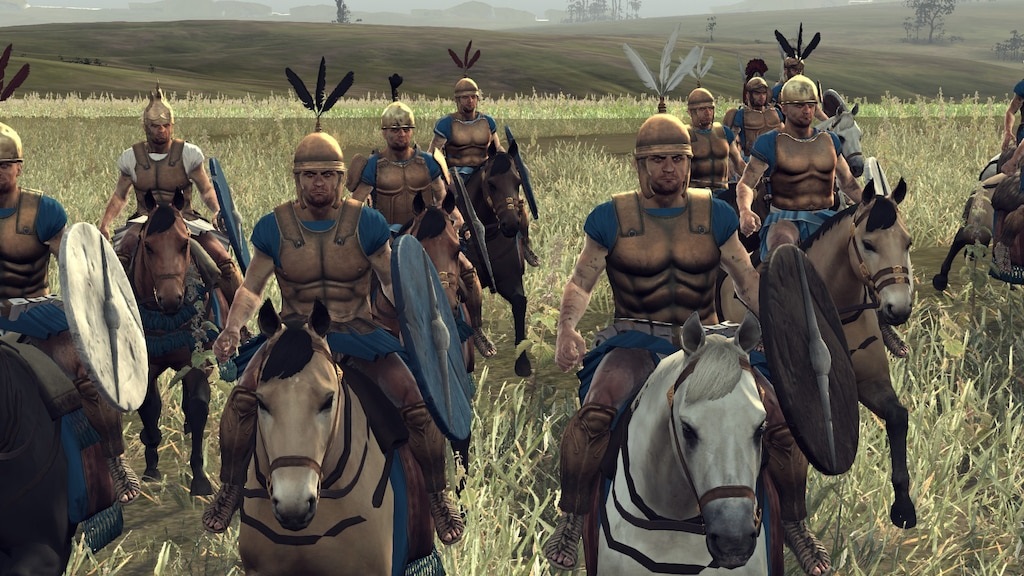
These men are excellent heavy cavalry, skillful at skirmishing tactics, fast enough to outrun cavalry, good at flanking charges and quite capable in melee thanks to their heavy armor, armor-piercing Kopis sword and their good shields.
Samnite, Campanian and Lucanian warriors. In a number
of hard-fought battles, the Romans defeated the Latin League, taking away the
sovereignty of their states, who subsequently assimilated into Latium. The
consul, Lucius Furius Camillus, asked the Senate: “Do you wish to adopt
ruthless measures against a people that have surrendered and been defeated? …
Or do you wish to follow the example of your ancestors and make Rome greater by
conferring her citizenship on those whom she has defeated.
The Campanians were reckoned amongst the best cavalry in
Italy – probably second only in reputation to the famous horsemen of Taras.
Italian and Roman cavalry fought with little armour during the 4th and 3rd
Centuries, preferring mobility and to use javelins (where-as the Macedonian
tradition favoured the lance and ‘contact’). Polybius goes so far as to say
that Roman Cavalry equipment was inferior to Greek equipment, and was changed
to be more Hellenic following contact with the likes of Pyrrhus and the
Successor Kingdoms (as well as the Hellenized Carthaginians). This change
probably took place towards the end of the 2nd Punic War, as the roman and
Italian Cavalry had been badly mauled by the Carthaginians.
From the 8th century BC, when Greeks settlers established
trading posts along Italy’s eastern seaboard in the vicinity of modern-day
Naples, the region of Campania was part of Magna Graecia. It remained so, a
stalwart of Hellenistic civilisation, until its aggressive Samnite neighbours
began to migrate from their mountainous homelands, displacing the Greek culture
and language prevalent there. In a land famed for its sweeping landscapes –
ideal for the breeding of strong horses – the emergent Campanian nobility
developed their renowned cavalry. Carrying heavy javelins for skirmishing and
swords for melee, they used speed, agility and flexibility of tactics to
inflict damage on more heavily armed, and therefore slower moving, opponents.
Following the Samnite Wars with Rome, around the beginning of the 3rd century
BC, Campanians provided the basis of the Socii cavalry attached to Roman
Legions. Well-trained in their people’s equestrian traditions, they were highly
valued horsemen and greatly respected warriors.
Livy wrote of two Roman cavalrymen during these years who defeated
Campanian opponents in single combat . These accounts are important because
they preserve the Roman need for moral victories at this time and are
emphasized precisely because they ran counter to the general pattern of
Campanian victories. The Roman heroes proved that the enemy cavalry would not
alway be victorious. In the first duel Cerrinus Vibellius Aurea. the finest of
all the Campanian horsemen, challenged Claudius Asellus, his former comrade and
the finest of all the Roman horsemen. The two riders wheeled and dodged one
another for a time without landing a blow. At last, Taurea challenged his
opponent to jump into a narrow ditch nearby where there would be no room for
evasion. Claudius accepted the challenge without hesitation, but Taurea balked
and returned to his ranks. The second duel happened several years later. A
recently successful sortie by Campanian and Carthaginian cavalry had damaged
Roman morale T. Quinctius Crispinus restored Roman morale by defeating the
Campanian Badius in a cavalry duel. The two had been guest friends, but Badius
renounced his ties and challenged Crispinus to battle. Crispinus transfixed his
spear in Badius shoulder, but Badius fled and avoided his deathblow. Crispinus
returned to the Roman camp with the arms and horse of his foe and received
praise and
The year 211 seems to have been the beginning of a turning
point for the Roman cavalry as Livy’s account of the creation of ne velites in
211 suggests. According to Livy, the quickest of the light infantry armed
themselves with small shields and seven javelins. Each cavalry trooper
transported one of these soldiers to within missile range of the enemy. The
light infantry dismounted and charged while casting their javelins in quick
succession against the enemy soldiers and horses. The cavalry followed up with
a charge and pursued the fleeing Capuans to the city gates against the enemy
soldiers and horses.
Livy incorrectly believed that the Romans first used velites
at this time; actually, light infantry had accompanied the legions well before
211. Nevertheless, there is no compelling reason to doubt that the Romans were
combining light infantry and cavalry in this manner at this time. This passage
suggests the Romans were attempting to develop innovative tactics to help their
cavalry overcome the opposing cavalry. Livy asserted this tactic ended the
dominance of the Campanian cavalry. Certainly, the Romans had reduced Capua by 211,
and the Campanian horse no longer posed a problem.
Socii infantry and cavalry Soldiers of roman army in
early era of Republic.
Equites Campanici (Campanian Cavalry)
Equites Campanici are renowned as the finest horsemen in
Italy, with the Samnites their only true rivals. They ride stout, if small, war
horses and are well trained. They are famed for their skirmishing tactics,
charging, retreating, and charging home again, engaging in melee only when they
fight small groups of isolated enemies. These men wear bronze armor, have stout
greaves, and carry javelins and the Greek Kopis sword with which to perform
their deadly efficient work.
Historically, Campania was ever a rich region in Italy.
Blessed with a fair amount of flat terrain, the horse farms of the nobility
provided a steady stream of cavalry with which to protect the capital, Capua.
Their final demise happened during the Second Punic War, when Rome took the
city after it had gone over to the Carthaginians. Its male population were put
to the sword or sold into slavery, ending the great tradition of cavalry.